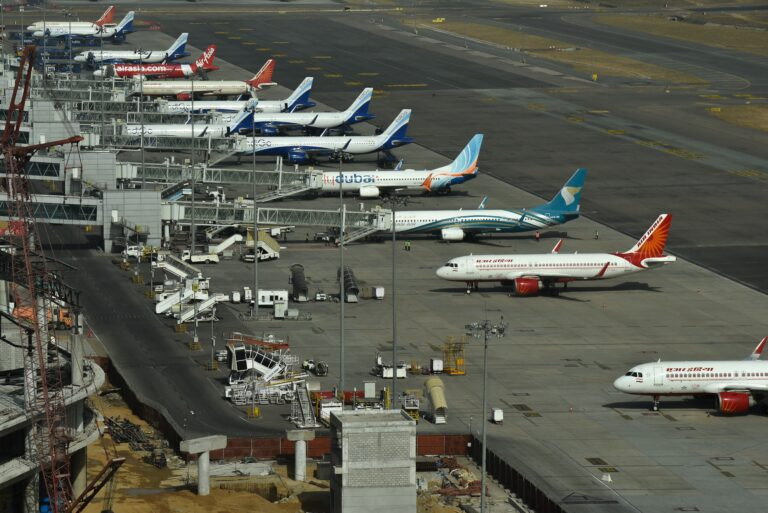India, with its rapidly expanding aviation and logistics infrastructure, is emerging as a key corridor in East–West and Global South–North trade. With airfreight accounting for over 35 percent of global trade by value—despite comprising only 1 percent by volume—the sector is undergoing a strategic transformation.
India’s growing role is particularly significant. The aviation sector directly employs 369,700 people and contributes US$5.6 billion to GDP. When including indirect and tourism-related activity, that figure rises to US$53.6 billion, or approximately 1.5 percent of national GDP—supporting more than 7.7 million jobs. The country’s annual airfreight throughput is projected to rise from 3.4 million tonnes in FY 2023–24 to over 10 million tonnes by 2030, placing capacity planning and policy reform high on the national agenda.
India’s logistics momentum
India’s logistics sector has seen significant investment under the Gati Shakti master plan, including airport expansion and fleet modernisation. However, cargo-specific infrastructure remains underdeveloped. As FedEx’s Richard Smith noted at the World Air Transport Summit (WATS), “India’s cargo throughput ambitions must be matched by real-time customs integration and better cross-modal interfaces at ports, railheads, and airfreight stations.”
Pieter Elbers, CEO of IndiGo, reinforced this point: “It’s not just about airside capacity—it’s about hinterland connectivity, data flows, and regulatory predictability. We need incentives for cargo-specific terminals and logistics SEZs to build resilient corridors.”
This call to action aligns with the government’s Unified Logistics Interface Platform (ULIP), which integrates data from more than 160 logistics nodes. While ULIP was highlighted as a model for integrated digital infrastructure, speakers acknowledged that scaling across customs and private systems remains a challenge.
Decarbonisation and SAF
Sustainability continues to dominate strategic planning. While much of the focus on sustainable aviation fuel (SAF) has centred on passenger carriers, the implications for airfreight are particularly urgent. Freighter aircraft often fly longer distances and operate with older, less efficient engines—making their emissions profile more problematic.
SAF currently accounts for less than 0.5 percent of global aviation fuel usage, highlighting the scale of the gap between ambition and implementation. A sustainability policy lead from a European cargo coalition warned, “Cargo can’t afford to be the laggard in emissions compliance. Without a clear pathway for SAF integration, freight operators will face mounting compliance costs under emerging carbon border adjustment regimes.”
Luis Gallego, CEO of International Airlines Group (IAG) and the newly appointed chair of IATA’s board, is expected to use IAG’s SAF experience to drive global scaling, especially in emerging aviation markets. His previous work at Iberia and British Airways indicates a policy-forward approach, aligning climate goals with operational resilience.
Geopolitics and network resilience
Geopolitical risk continues to reshape cargo routing strategies. The Red Sea crisis, overflight restrictions in Central Asia, and growing dependence on alternative hubs such as Nairobi and Hyderabad are forcing operators to rethink network architecture.
Adrian Neuhauser, CEO of Abra Group, argued for decentralisation: “We cannot rely on legacy hubs. Strategic diversification of cargo gateways and fallback corridors is essential for time-sensitive goods.”
This shift is prompting calls for state-level coordination on cargo contingency planning and airfreight emergency response protocols—particularly for sectors handling perishable or pharmaceutical shipments.
Financial infrastructure and trade enablement
A key challenge highlighted in discussions was the cost of cross-border transactions in airfreight. “Up to 3 percent of transaction value is absorbed in clearing, FX spreads, and cross-border payment charges,” said Joanna Geraghty of JetBlue, during a panel on financial innovation.
Solutions discussed included blockchain-enabled settlement systems and digital wallets that could integrate with air waybill and customs data. Industry voices also urged that airfreight payments be designated as essential trade flows—especially in jurisdictions with capital controls and currency repatriation restrictions. This is particularly relevant in light of IATA’s recent announcement that US$1.3 billion in airline revenues remain blocked in multiple countries, affecting liquidity and route planning.




